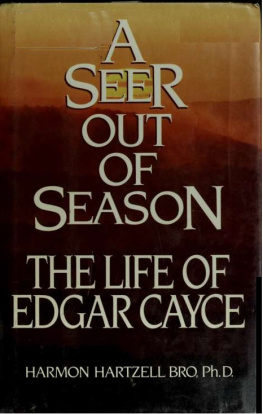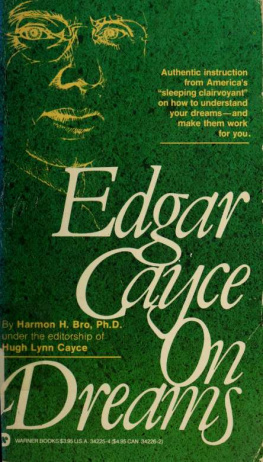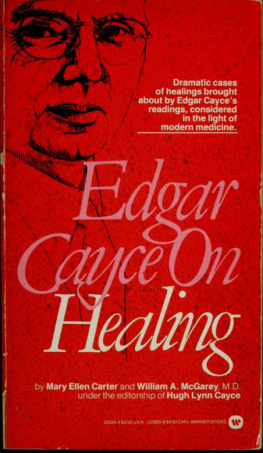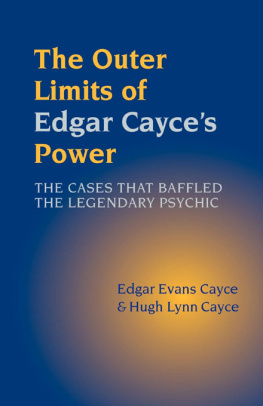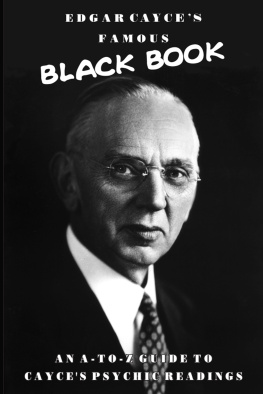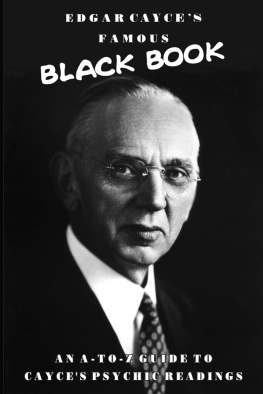Edgar Cayce
A SEER
out of
SEASON
Edgar Cayce
A SEER
out of
SEASON
The Life of Historys
Greatest Psychic
HARMON HARTZELL BRO, PH.D.

Copyright 1989
by Harmon Hartzell Bro
A.R.E. Press Edition
1st Printing, April 2011
Printed in the U.S.A.
All rights reserved. No part of this book may be reproduced or transmitted in any form or by any means, electronic or mechanical, including photocopying, recording, or by any information storage and retrieval system, without permission in writing from the publisher.
A.R.E. Press
215 67th Street
Virginia Beach, VA 23451-2061
ISBN 978-0-87604-604-3
New American Library edition published 1989
Edgar Cayce Readings 1971, 1993-2007
by the Edgar Cayce Foundation.
All rights reserved.
Cover design by Christine Fulcher
To my graduate students, who for nearly half a century have taught me so much with their questions and creations, and to those bold graduate students of the next half century who will try to figure out where seers and open vision belong in our culture.
And to my wife, June.
The best (including most absorbing) account that has been written about historys best-documented psychic. William James would have liked this book.
Huston Smith,
author of The Worlds Religions and Forgotten Truth
Contents
Part I
The Gift: Love Surprised by Wisdom
Part II
The Roots: Cayce Before Cayce
Part III
The Life: Wrestling through the Dawn
PREFACE
Harmon Hartzell Bro, Ph.D. (1919-1997) was a psychotherapist, an educator, a writer, an ordained minister, and an inspirational lecturer. As a young man, he lived and worked in the Cayce home and witnessed several hundred readings. That experience enabled him to come to know Edgar Cayce better than most individuals who have written about the Cayce legacy. Eventually, Harmon wrote his doctoral dissertation on Cayces life and work, as well as several books about the Cayce information, including this one, Edgar CayceA Seer Out of Season.
Harmon first came to Virginia Beach in 1943 as a young minister, just graduated from Divinity School at the University of Chicago. He came to meet Cayce first-hand, as he was both curious and troubled that his mother, Margueritte Harmon Bro, had become involved with Cayces work. However, what Harmon witnessed in Virginia Beach was very different than anything he might have imagined. An October 1943 letter to his wife, June Avis Bro, expressed his enthusiasm for a work that would transform his own life. That letter stated, in part, the following:
Thin tubercular women, crippled boys, cancerous workmen, arthritic grandmothers knotted in painthey all find healing. But thats only the beginningwhat really happens to them is what has happened to Mr. and Mrs. Cayce, Gladys Davis [Cayces secretary] and some othersthey find that there is a river of Gods love flowing about us all, only waiting to be tapped by humble minds. The real miracles at Virginia Beach are the radiant, transformed lives, the people who go away realizing that they can actually find God and know Jesus and live like it. They say, I am my brothers keeper and their lives show it. They say, There is only one God and all their friends feel it. Buddhist, Muslim, Jew, Catholic, Mennonite, Christian Scientist, Humanist, Presbyterianit goes on like the Ballad for Americansthey all find what they are searching for in the work of the readings and Mr. Cayce...
Harmon and June Bro moved to Virginia Beach and became close friends with the Cayce family and worked as members of the Cayce office staff. At the time, there was a tremendous increase in requests for Cayces readings as a result of the publication of Cayces biography, There Is a River, by Thomas Sugrue, which was followed by Margueritte Harmon Bros own article in Coronet magazine entitled Miracle Man of Virginia Beach. Harmon and June listened to hundreds of readings. They had access to all correspondence, and they had the opportunity to repeatedly see how peoples lives were changed by the Cayce work.
Harmon became interested in psychology and decided to continue graduate work. He went on to Harvard and then to the University of Chicago where he did a doctoral dissertation based on a study of the Edgar Cayce readings. For this dissertation, he coined the following phrase for Edgar Cayce: a seer in a seerless culture.
Harmon called the story of Edgar Cayces life one of the most challenging and appealing adventure stories of modern times. He went on to explain that the story was about much more than a psychicmuch more than he had ever expected when he first came to Virginia Beach as a young man:
... to call him a psychic is to call an opera star an athlete of the vocal cords. For Cayces aid was not simply raw data dumped on frantic seekers, but carefully devised counsel as fraught with values as with information. He spoke not only of organs and tissues and interventions, but of justice and love, and of beauty and holiness, as the context for healing and wholeness. Only a time so impotent for personal and social goodness that it must seize on powers ahead of meaning would be satisfied with labeling him a clairvoyant. To find his visionary yet practical gift, one must remember Judaisms Baal Shem To combining healing with mystical vistas, Melville viewing the world from the bowels of whales, Blake painting fiery creation, Freud finding darkness and light through sexuality, and Jung glimpsing with Plato the starry heavens of archetypes within human deeps.
Cayce was not fascinated with his own prowess, though others often were. Nobody who knew him well could imagine that he went to bed at night and got up in the morning thinking about his trance skills and how to improve themany more than he focused on his paranormal abilities outside of trance, such as seeing revealing colors (auras) around others, reading minds, conversing with the recently dead, or previewing the future. His concern was not first of all with powers but with relationships. On the one hand he sought to be deeply and helpfully related to the damaged persons that he served. And on the other hand he sought to be related to the divine, which he saw as the ultimate author of his gifts, within the kind of community and tradition that serves such a source. This was a man who lay down and arose with prayer, not as duty or accomplishment, but as a hunger reaching for companionship with God, seeking to be grasped more than to grasp, so that he might create usefully for those who wept with pain.
Harmons book presents an eyewitness account of Cayce at work. It draws upon Harmons personal experiences, as well as upon hundreds of interviews with Cayces relatives, associates, sufferers seeking aid, and even some disappointed detractors. It presents a story of a man with tremendous gifts, tremendous challenges, and tremendous love for God and the human creation.
When Edgar Cayce died on January 3, 1945, in Virginia Beach, Virginia, he left well over 14,000 documented stenographic records of the telepathic-clairvoyant statements he had given for thousands of people over a period of forty-three years. These documents are referred to as readings. In 1931, Cayce founded the Association for Research and Enlightenment (A.R.E.) to research, document, and disseminate his psychic information.
The readings constitute one of the largest and most impressive records of psychic perception ever to emanate from a single individual. Together with their relevant records, correspondence, and reports, they have been cross-indexed under thousands of subject headings and placed at the disposal of psychologists, students, writers, and investigators from around the world.
Next page

